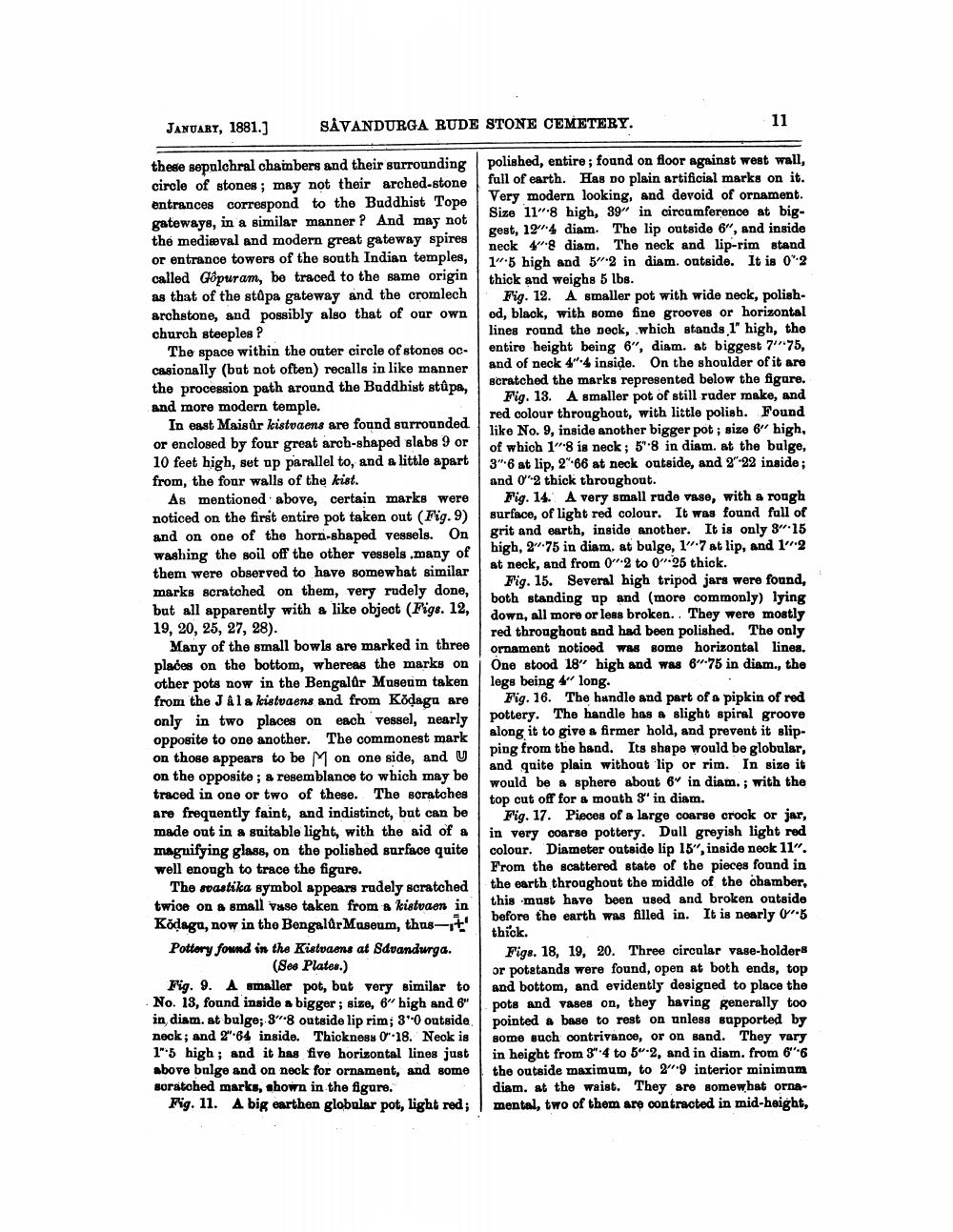________________
11
JANUARY, 1881.)
SÅVANDURGA RUDE STONE CEMETERY.
these sepulchral chainbers and their surrounding polished, entire ; found on floor against west wall, circle of stones; may not their arched-stone full of earth. Has no plain artificial marks on it.
Very modern looking, and devoid of ornament. entrances correspond to the Buddhist Tope
Size 11":8 high, 39" in circumference at biggateways, in a similar manner ? And may not
gest, 124 diam. The lip outside 6", and inside the medieval and modern great gateway spires
neck 4.8 diam. The neck and lip-rim stand or entrance towers of the south Indian temples,
1":5 high and 5'2 in diam. outside. It is 09:2 called Gópuram, be traced to the same origin
thick and weighs 5 lbs. as that of the stôpa gateway and the cromlech Fig. 12. A smaller pot with wide neck, polisharchstone, and possibly also that of our own od, black, with some fine grooves or horizontal church steeples ?
lines round the deck, which stands 1" high, the The space within the outer circle of stonos oc- entire height being 6", diam. at biggest 775, casionally (but not often) recalls in like manner and of neck 4":4 inside. On the shoulder of it are
scratched the marks represented below the figure. the procession path around the Buddhist stúpa,
Fig. 13. A smaller pot of still ruder make, and and more modern temple.
red colour throughout, with little polish. Found In east Maisûr kistvaens are found surrounded
liko No. 9, inside another bigger pot; size 6" high, or enclosed by four great arch-shaped slabs 9 or
of which 1":8 is neck; 5:8 in diam. at the bulge, 10 feet high, set up parallel to, and a little apart
3.6 at lip, 266 at neck outside, and 2"-22 inside ; from, the four walls of the kist.
and 02 thick throughout. As mentioned above, certain marks were Fig. 14. A very small rude vase, with a rough noticed on the first entire pot taken out (Fig. 9) surface, of light red colour. It was found full of and on one of the horn-shaped vessels. On grit and earth, inside another. It is only 3.15 washing the soil off the other vessels .many of
high, 2.75 in diam, at bulge, 1":7 at lip, and 1" 2 them were observed to have somewhat similar
at neck, and from 0.2 to 0.25 thick.
Fig. 15. Several high tripod jars were found, marks scratched on them, very rudely done,
both standing up and (more commonly) lying but all apparently with a like object (Figs. 12,
down, all more or less broken.. They were mostly 19, 20, 25, 27, 28).
red throughout and had been polished. The only Many of the small bowls are marked in three ornament noticed was some horizontal lines. places on the bottom, whereas the marks on One stood 18" high and was 6-75 in diam., the other pots now in the Bengalur Museum taken legs being 4" long. from the Jala kistvaens and from Kodagu are Fig. 16. The handle and part of a pipkin of red only in two places on each vessel, nearly
pottery. The handle has a slight spiral groove opposite to one another. The commonest mark
along it to give a firmer hold, and prevent it slip
ping from the band. Its shape would be globular, on those appears to be M on one side, and U
and quite plain without lip or rim. In size it on the opposite ; a resemblance to which may be
would be a sphere about 6" in diam. ; with the traced in one or two of these. The scratches
top cut off for & mouth s' in diam. are frequently faint, and indistinct, but can be Fig. 17. Pieces of a large coarse crock or jar, made out in a snitable light, with the aid of a l in vare
in very coarse pottery. Dall greyish light red magnifying glass, on the polished surface quite colour. Diameter outside lip 15", inside neck 11". well enough to trace the figure.
From the scattered state of the pieces found in The svastika symbol appears rudely scratched
the earth throughout the middle of the chamber, twice on a small vase taken from a kistvaen in
this must have been used and broken ontside Kõdagu, now in the Bengalur Museum, thus-1'
before the earth was filled in. It is nearly ( 5
thick. Pottery found in the Kistvaens at Sdvandurga. Figs. 18, 19, 20. Three circular vase-holder (Ses Plates.)
or potstands were found, open at both ends, top Fig. 9. A smaller pot, but very similar to and bottom, and evidently designed to place the No. 13, found inside a bigger ; size, 6" high and 6" pots and vases on, they having generally too in diam, at bulge; 3.8 outside lip rim; 30 outside pointed a base to rest on anless supported by neck; and 2.64 inside. Thickness 018. Neok is some such contrivance, or on sand. They vary 1"-5 high; and it has five horizontal lines just in height from 3" 4 to 5.2, and in diam. from 66 above bulge and on neck for ornament, and some the outside maximum, to 29 interior minimam Boratohed marks, shown in the figure.
diam. at the waist. They are somewhat ornaFig. 11. A big earthen globular pot, light red; mental, two of them are contracted in mid-height,




